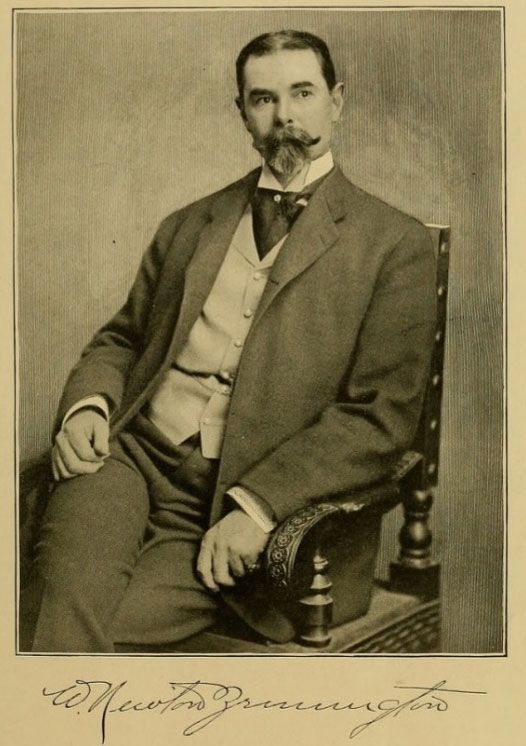
The impeccable W. Newton Bennington. From the Official Souvenir Program Belmont Park “Opening Day,” May 4, 1905.
“Money is our Madness,
our vast collective madness.” - D.H. Lawrence
A theatrical trade journal of the early 1900s mentioned that the American Nation may well be proud of its peerless resort of healing waters and sportsmen, which with the prestige of generations the leaders in society, racing, and all the departments of life, Saratoga Springs is a blossom fragrant to the senses of all. A gentleman who appeared during that same time period was W. Newton Bennington, who arrived as a thoroughbred owner. A Buckeye by birth, Mr. Bennington relocated to Canada where he began his involvement in the Sport of Kings which included huge bets, quickly becoming a fixture at race tracks everywhere.
In Chicago, the horses Mr. Bennington brought attracted the attention of William A. Pinkerton, the famous detective and guardian of race tracks and bookmakers. Through this association, Newton Bennington was introduced at Saratoga, to Gilded Age industrialist and gambler John W. Gates. Mr. Bennington was able to provide “Bet-A-Million” Gates, who was always anxious for information for wagering purposes, with the dope on his Canadian sleepers. This resulted in several long-shot winners for Mr. Gates, who got away with the scorched bookmakers coin. In return, young Newton Bennington profited from numerous Wall Street insider tips, which he soon converted into well-played personal capital, his good fortune making good copy for the daily publications of the era.
He was a style setter, with a noteworthy and fashionable appearance, always attired in fine dress. Mr. Bennington mixed well with the celebrities of stage and sport, and developed a warm friendship with heavyweight boxing champion Jim Fitzsimmons. In his personal life he was married to the former Bessie Taylor, who was a theater actress and an early labor organizer for performers. She also raised competition dogs, with Newton becoming devoted to her efforts, in all respects.
As a blue-water yacht racer, Newton Bennington gained fame with eastern clubs, and he began to spread his investment portfolio toward real estate development with large suburban projects on Long Island. His keen eye for potential wealth expansion was applied in Saratoga County and led toward the development of Bennington Park, along the planned enlarged canal in Mechanicville. In 1902 Mr. Bennington purchased more than 21 acres in Saratoga Springs, described in the Deed as the lands of Rockwell Putnam, which stretched north from Washington Street to Church Street. He later filed a tract map for this property, laying out new streets and 350 building lots, under the name of Bennington Terrace, with a sales office in the notable Fonda Building at 384 Broadway in Saratoga Springs.
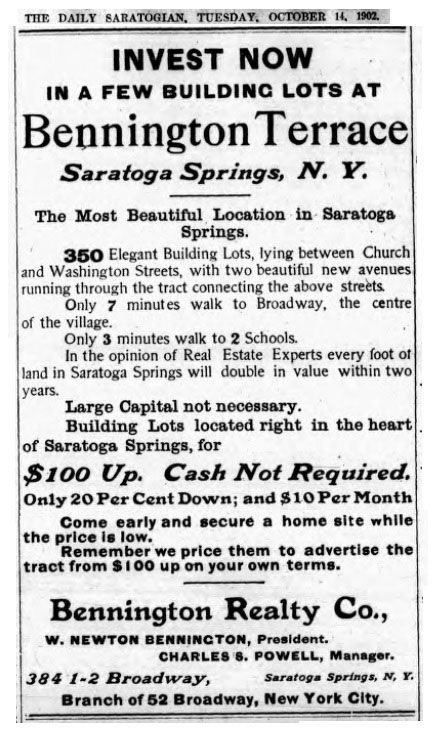
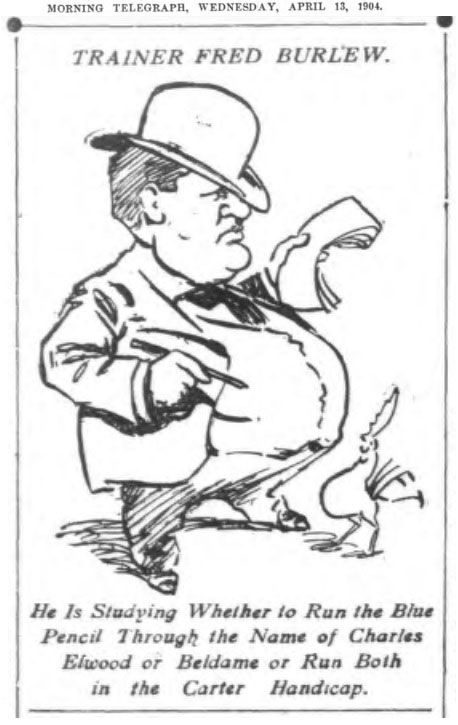
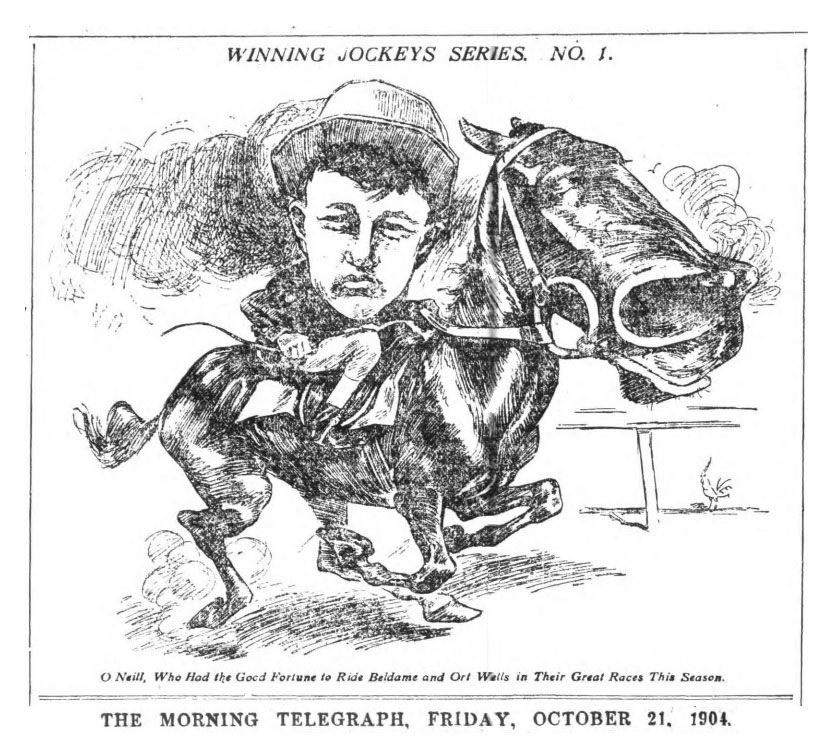
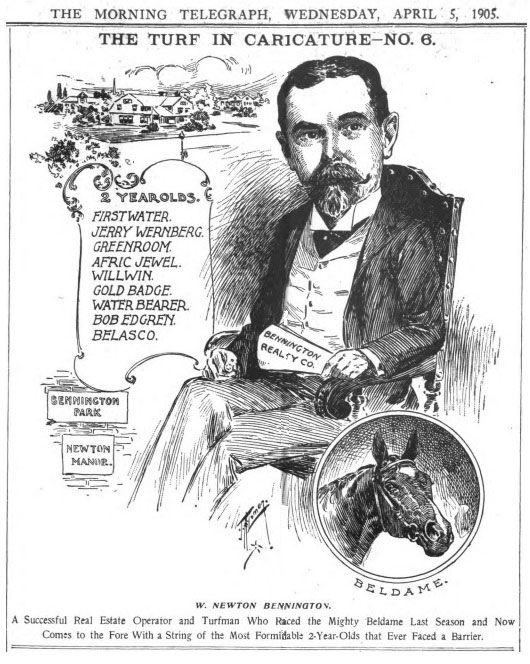
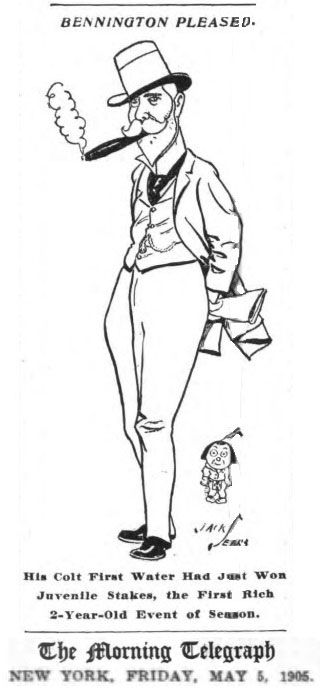
Later that year Mr. Bennington’s had health issues, requiring two operations, which impacted his well-being and continued into the following spring. The Daily Racing Form reported May 19, 1907,
“Newton Bennington, the New York turfman, had a narrow escape from death in Canada last week. Mr. Bennington has some mining interests at Cobalt and went there on a trip of inspection. He lost his footing, fell over the edge of a cliff and would have dropped several hundred feet had not his coat caught in the branches of a tree some twenty feet from where he fell. He was unconscious when rescued several hours later. He is still suffering from the shock, which was all the more severe because of two operations he underwent last winter. He also made huge real estate profits at Bath Beach and Bensonhurst, Long Island. His Canadian Farm at Cobalt had been foreclosed upon. Mr. Bennington said that while racing might be a fine sport, it is a poor business.”
It seems so unfortunate that he came to a bad way financially as well as physically, as judgments by default became public knowledge, followed rapidly by the loss of much of his fortune on Wall Street, and Newton Bennington found himself over-extended in real estate. Bessie decided the best intervention for the disorder was to have him committed to a sanitarium. The Washington Post on September 17, 1907, screamed out in a headline,
“TURF CELEBRITY IN ASYLUM:
W. Newton Bennington Said To Have Lost Mind And Fortune.”
The Daily Racing Form wrote on the same day,
“As the result of an inquest of lunacy, Newton Bennington is now an inmate of a sanitarium for the insane near Flushing, Long Island. This serves to throw light on actions and wild statements that brought surprise, to say the least, to his friends, at various times within the past few months. Bennington was a turfman of extensive operations and quite successful. He was usually a heavy purchaser at the Haggin yearling sales and developed a number of crack two-year-olds that sold for large sums after having won valuable stakes, with them. He leased the running qualities of Beldame from August Belmont and swept the boards with her when she was a three-year-old. He was considered a wealthy man, but it has recently been stated that he is in straightened circumstances financially.”
By July 3, 1908 the Daily Racing Form had a more troubling headline,
“Once Famous Turfman Escapes from Sanitarium in Which He Is Confined in Corona, Queens.” And further reported in conversation with a relative that he only “constantly twirled his mustache, the ends of which he had trained to point upward in Kaiser Wilhelm style.”
In 1912 the State Supreme Court in Brooklyn appointed a guardian for Newton Bennington, and with Bessie Bennington agreeing to care for her husband, he was released as legally sane. Demonstrating sound logic and a continued interest in the marketplace, at the height of the Great Depression, Newton Bennington opined his frustration to the Editors of the New York Times on August 20, 1931 that the price of a loaf of bread remained high, despite the record low price of wheat. The couple lived out their lives quietly in Manhattan into the middle 1940’s and are interred together in the Kensico Cemetery.